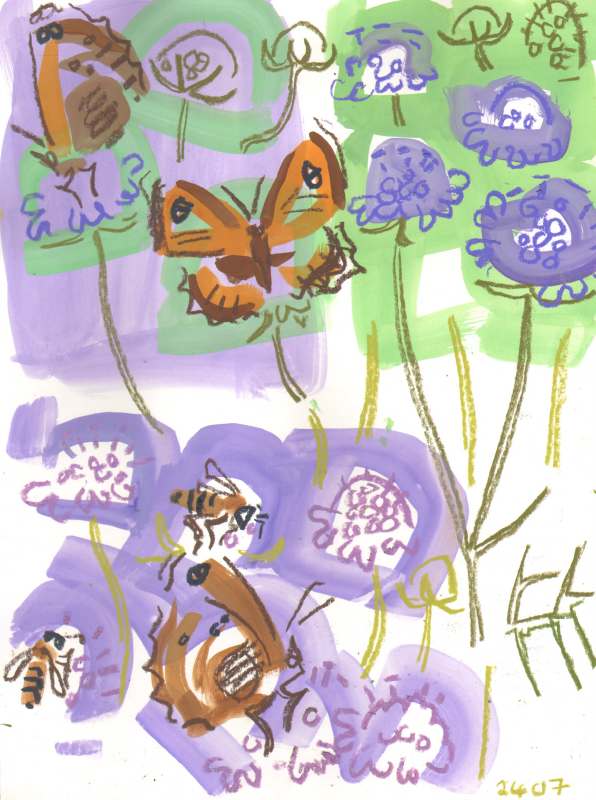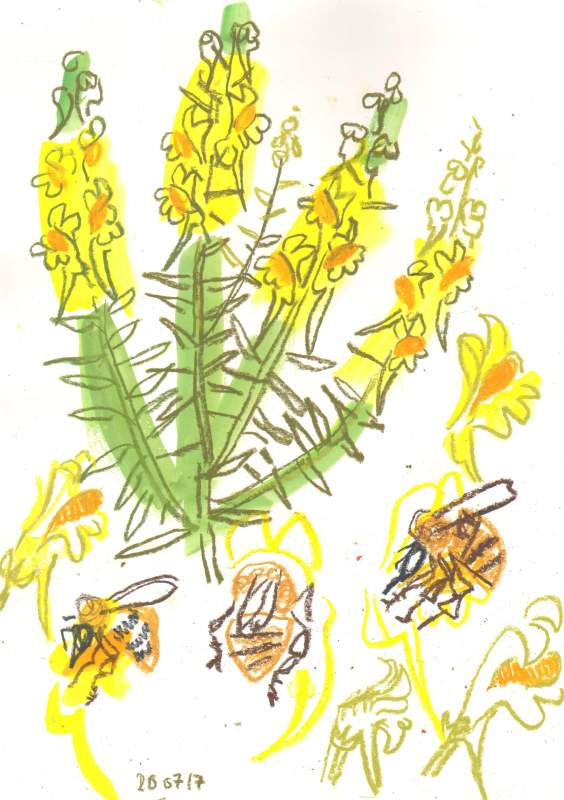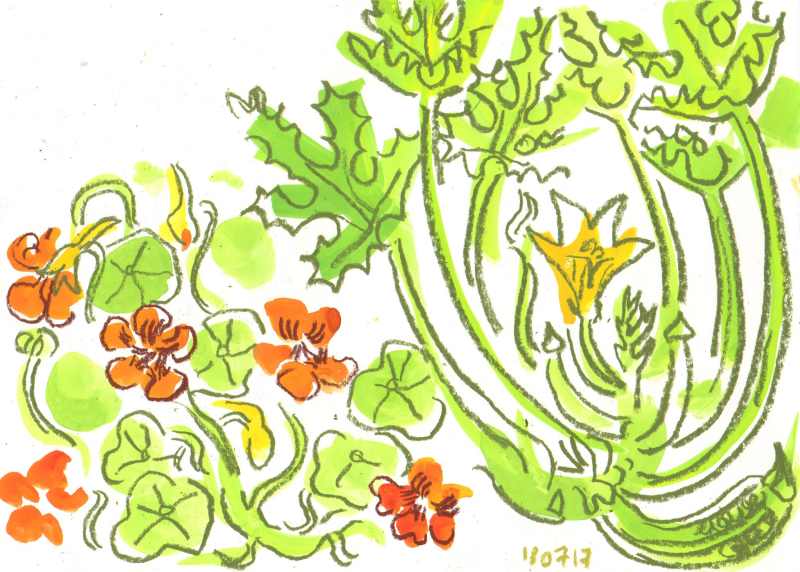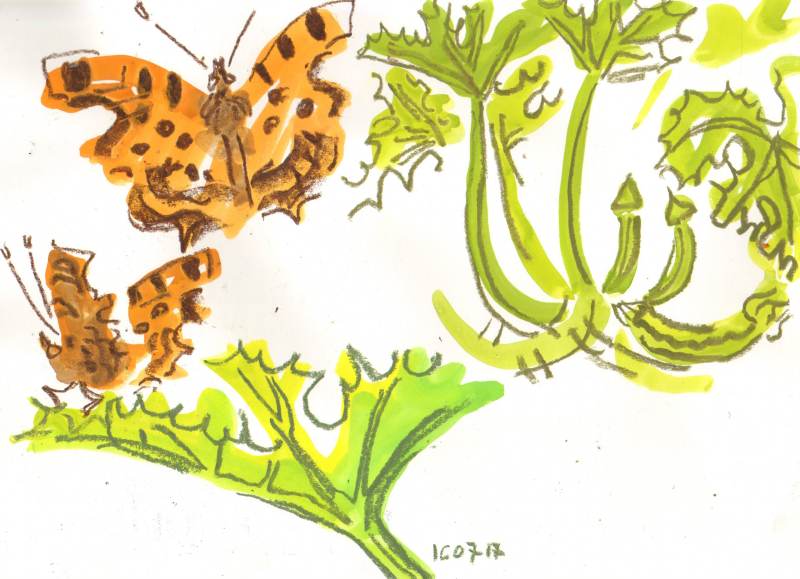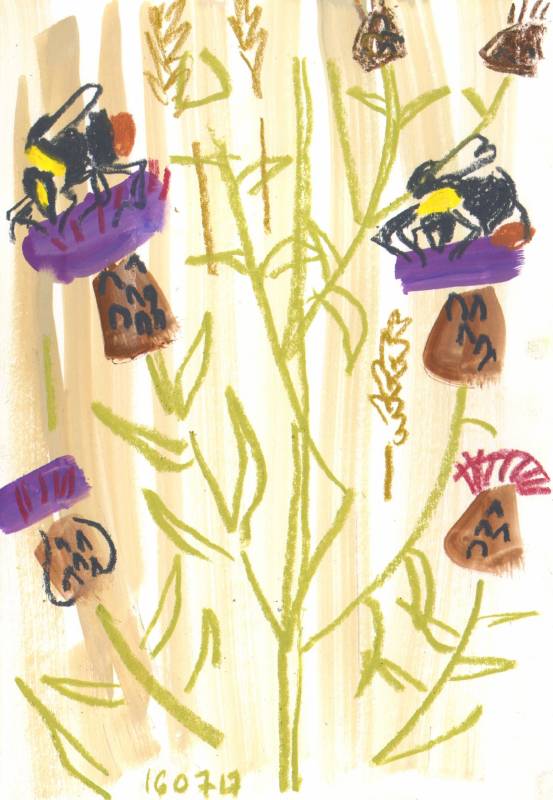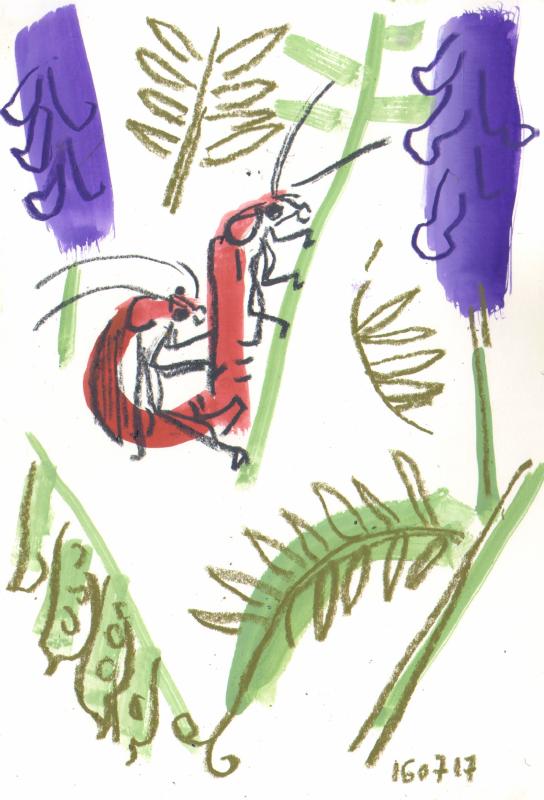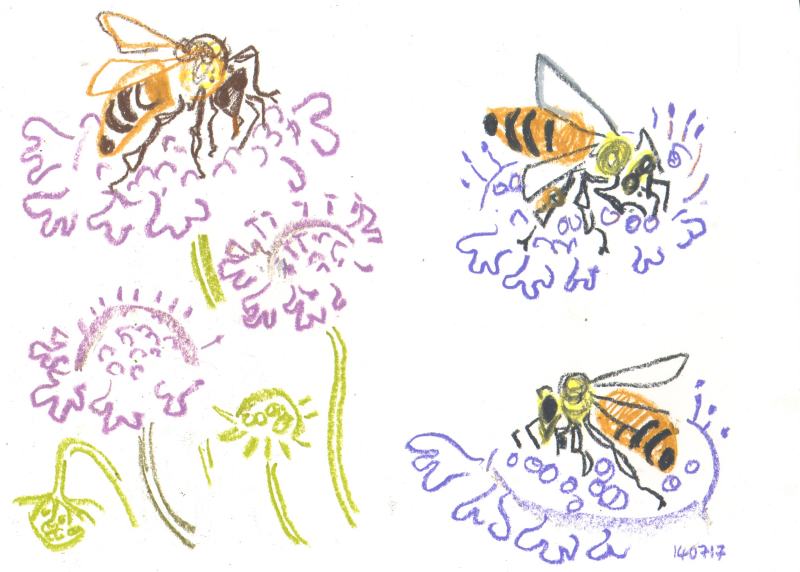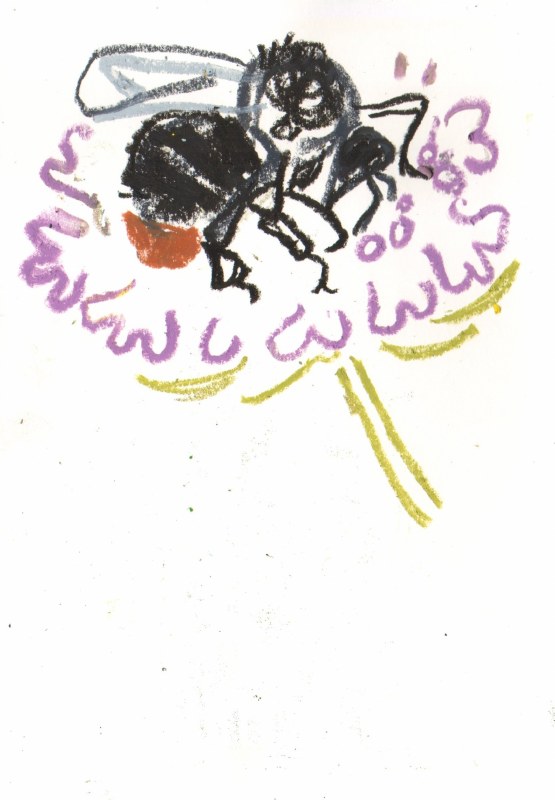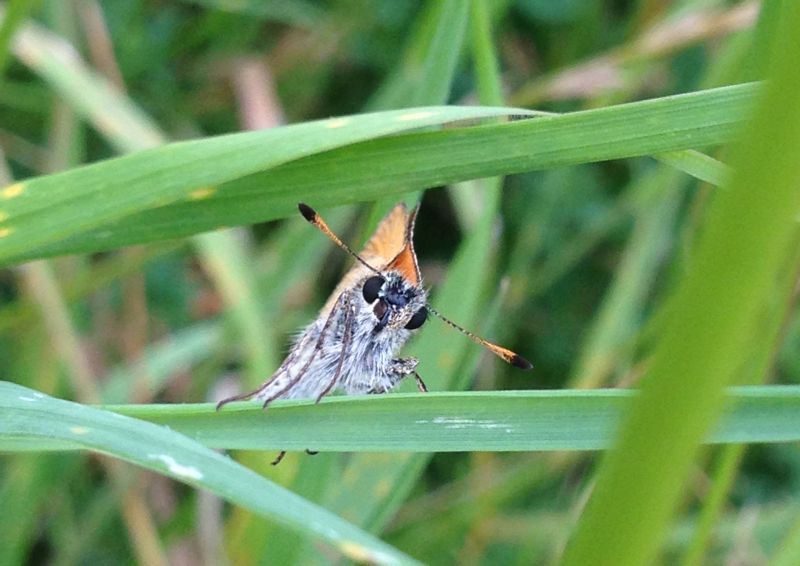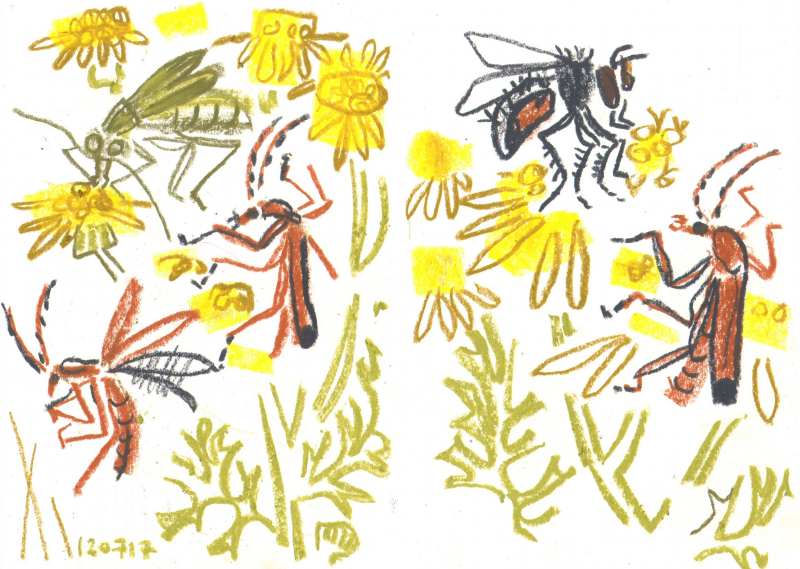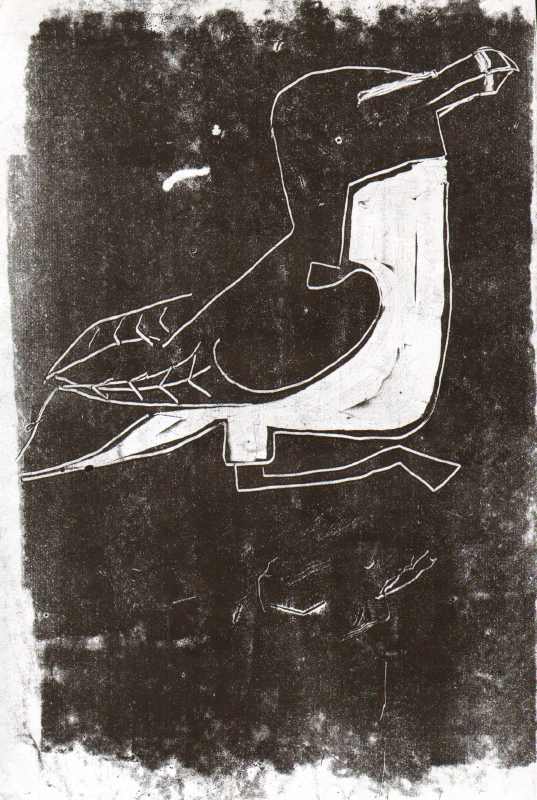After 3 days of poor weather insects out in force, feeding up. More meadow browns but looks like the end of the ringlet season. The straggly knapweed candelabras busy with mainly male red-tailed bumblebees, shoulders and forehead tuft a sherbet lemon.
The only species of bee I’ve seen visiting the toadflax, but there are ants and tiny beetles trying to find access to the nectar. The opening is above the pouting orange lip but has a rim of hairs which make it hard for these pygmies to enter… it needs the weight of a bumble to open the hatch.
The common carders have really long tongues, I’d guess not as long as garden bumbles…. but the gardens all seem preoccupied with nasturtiums.
Yesterday in the heat before the storm making more ‘collection’ studies… When I’d been sketching the one below on the previous day I realised I knew less about the big ‘glossy’ species than I did about the more bit part players.
The allotment is on quite a slope and I’ve been cultivating wildflower banks as a means of retaining soil and creating wildlife habitat. So now I’ve often got the wild stuff sitting alongside the veg. To get the veg. more convincingly into the picture I started courgette studies and then moved onto nasturtiums…. next will be the runner beans … which now have toadflax and hemp agrimony flowering alongside them.
While making the sketch above a hummingbird hawkmoth patrolled up and down the bank… seemed to be egg laying on the gone over clusters of ladies bedstraw flowers.
Blocking in elements with goauche to make some kind of architecture to hang the crayon drawing on.
In the sun lots of butterfly activity, adding a kind of electricity to the vibrant colours in the plant life (nasturtium flowers and runner beans, poppies etc… that I’ve yet to deal with).
Female gatekeeper, forewings a sea of orange.
Honeybees with troubador hindlegs (something of them expanding to a wide flattened boot) . Sinking their small heart shaped faces into pillows of marshmallow scabious.
Need more work and more exagerration to find the form and feel of the red-tails… quick moving buzz, fuzz of blackness.
Finding two new species for the meadow… a single roesel’s bush cricket… last seen/sketched in Turkey. Given more scrutiny of the skippers I realised that some of them are essex skippers with the dipped in ink undersides to antennae… So three species of skipper on this little scrap of land.
More collection of detail. Small skippers one of the most obvious protagonists on the meadow at this time of year. Flashes of orange copper. Miniscule and tricky to get a feeling for their anatomy. One pair mating, clasped together for at least 3/4 of an hour….The orangey species are the most prominent butterflies at present… gatekeeper, more focussed on brambles but coming to bask in the meadow. Commas sunning on large surfaces like the leaves of courgettes. Large skippers seem to have had their day, only one or two now around. Meadow browns and gatekeepers are in small numbers. A few whites, large and small, no green-veined at the moment. Of the other vanessids I only see the occasional red admiral, no peacocks, tortoiseshells or painted ladies. The buddleia is all in flower but no takers in these parts.
Re-engaging with fieldwork discipline after various family related escapades. Gradually building up some fluency in how to deal with plants and insects. There were more species on the carrot… including spider hunting wasps but figured that I should try to learn to draw one creature (the soldier beetle) and then build from there.
As ever the drawing is a good way of learning about the subject matter and I’m pretty sure the fly below is Eriothrix rufomaculata… and the beetle is a fat-thighed flower beetle but a female without the swollen, bandy, globe upper legs of the males…
The last day, a bit disrupted because I had to take the van into the garage. Forgot my larger monoprinting perspex and consequently limited to A5 plates. Still having the feeling that I was only touching the surface of the field monoprinting….
These guillemots are pretty much what I already knew…but little things like the speckling for rock texture and the blockiness of the feet …as well as very quick definition of space through scraping out areas is exciting for me.
A pod of bottle-nosed dolphins went through several times. One with a pale leading edge to dorsal fin and one visible under water showing pale belly, possibly suckling youngster?
They were putting up the rafts of guillemots as they broke the surface. The swap from ‘negative ‘ drawing to brushed ‘positive’ for the dolphins in these 2 sketches giving food for thought….. there is something more descriptive of the elusive rise and fall and the moving water in the brushed drawing…
I could brush on blocks for the guillemot darks and then scrape into them to give more detail.
This last small print has something of the frenetic frenzy of the kittiwakes calling and spiralling on updrafts… more related to the sculpture than drawing I think…..
This was a day of revelations for me. Firstly seeing how people could do the equivalent of quick life drawings as an excercise… (described here).
Then lead tutor Darren Woodhead had bought clay for us to make some kind of 3D representation of what we were seeing. We convened at the top of the cliffs in the afternoon and people settled to pushing the air drying clay around and engage with the subject matter in a different way.
I had an idea how I wanted to approach it… to combine drawing with the 3D making…I’d been monoprinting razorbills so carried on with them (I’ve really struggled with the pattern vs form of razorbills in the past) at first it was muddly moulding and everything rounded off with forms briefly found then lost.
I decided to start to construct building blocks…. first something like the base of a kayak… the flattened curving belly of the razorbill with sharp pointed bristle tail. as in top left of drawing. Each time I made new components I tried to draw them and their was something new in manufacturing forms in real space and then translating them into 2D. Changing the way of drawing and the way the sheet got filled.
The lump of clay on the window sill back home doesn’t seem a big deal but I know it has changed something in the brain.
Even the drawings from the ‘sculpture’ have a quality of their own.
Not so easy to get out to the islands these days and this year we only managed to get on the Bass rock for about an hour. We split into 2 groups leaving from Dunbar harbour with people sketching kittiwakes whilst waiting for the boat.
Last year one of the pivotal moments of the course was 2 hours circling the Bass on the large boat ‘Sula bassana’. This seemed to really focus everyone and there was a great sense of people working away intensely with everything whirling around the vortex of concentration.
This year the second boatload had about a quarter of an hour offshore giving the first group a bit more time to sketch before swapping over and letting us land to have our hour with the gannets.. The time working from the boat seemed like a warm up ‘quick pose’ session to get in training for the hour ashore which passed in no time.
The volume and quality of work produced in a very short time, with lots of people making huge advances prompted us to do timed drawing exercises the next day. Amazing that we’d never thought to do it before (it is a staple of life drawing classes)… the results were generally exciting and in some cases it hardly seemed credible how much people could get on paper in 30 seconds. (see this post)
